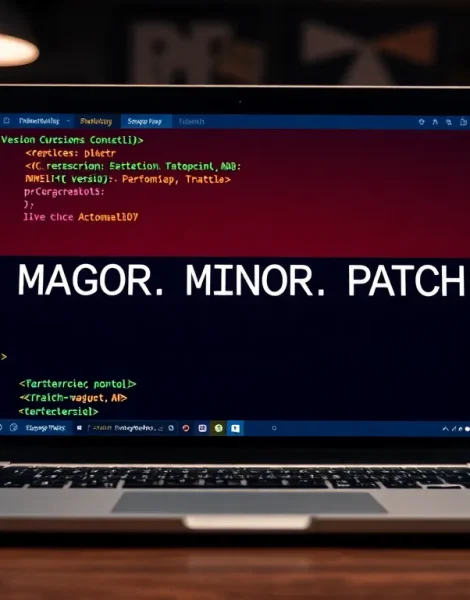In the world of software development, keeping track of changes can feel like herding cats. Enter semantic versioning, the superhero of version control. It’s not just a fancy term; it’s a lifesaver that helps developers communicate clearly about updates, fixes, and new features. Think of it as the GPS for your software journey—navigating through the chaos of releases with style and precision.
Table of Contents
ToggleOverview of Semantic Versioning
Semantic versioning employs a three-part version number format: MAJOR.MINOR.PATCH. Each segment conveys specific information about the modifications made to software. For instance, an increase in the MAJOR version indicates breaking changes. Users must adapt their code when upgrading.
When the MINOR version changes, new features may be added without breaking existing functionality. Users benefit from enhancements and improved performance with this type of update. PATCH versions, however, focus on backward-compatible bug fixes. These small changes aim to address issues without introducing new features.
Standard practices in semantic versioning offer a clear structure. Using a consistent versioning method enhances communication among developers and stakeholders. Clarity in versioning prevents confusion, allowing for smoother integration of updates. GitHub and npm exemplify platforms that utilize semantic versioning effectively.
Software dependency management greatly relies on semantic versioning. Dependencies often specify version constraints based on semantic versioning rules. This ensures compatibility and stability within software projects. For example, a library requiring a major version of 2.0 might not work with changes introduced in version 3.0.
Thus, semantic versioning serves as more than just a numbering system. It defines relationships between releases and signifies the nature of changes. By adhering to these standards, developers maintain a robust ecosystem of applications.
The Importance of Semantic Versioning

Semantic versioning plays a vital role in the software development landscape. It offers clarity on how changes impact functionality and user experience.
Benefits for Developers
Developers gain significant advantages from using semantic versioning. It standardizes the way they communicate changes, making updates predictable. Teams can easily identify breaking changes through the MAJOR version number. Changes in the MINOR version highlight new features added without disrupting existing code. The PATCH version denotes safe bug fixes, ensuring developers understand their impact. Thus, the structured versioning enhances collaboration, allowing teams to manage dependencies effectively. With platforms like GitHub and npm adopting semantic versioning, developers streamline their workflows, resulting in increased productivity.
Benefits for Users
Users benefit greatly from semantic versioning practices. Enhanced transparency occurs when they can quickly grasp the nature of updates. Understanding which changes are critical minimizes unexpected disruptions. Users feel more secure knowing that MAJOR version increments signal potential breaking changes. Meanwhile, MINOR and PATCH updates reassure users with new features and bug fixes that maintain compatibility. As a result, they experience fewer issues during software updates, leading to a smoother user journey. Overall, the clarity provided by semantic versioning fosters trust and satisfaction among users.
Components of Semantic Versioning
Semantic versioning comprises three key components: Major, Minor, and Patch versions. Each segment carries distinct meanings, guiding developers in managing software changes.
Major Version Changes
Major version changes occur when significant alterations impact compatibility. An increase in this number signals breaking changes that require users to modify their code for successful integration. Features might be restructured or removed entirely, affecting existing functionality. Developers often face challenges when transitioning between major versions, making rigorous testing essential to ensure a smooth upgrade experience. Examples of impactful major changes include migrations to new architecture or frameworks, which necessitate careful planning and communication.
Minor Version Changes
Minor version changes introduce new features without disrupting backward compatibility. This increment signifies enhancements and additional functionality that augment the existing software while maintaining current stability. Developers’ enhancements might include performance optimizations, improved user interfaces, or expanded APIs. Users usually appreciate minor updates as they get access to new features without facing extensive modifications. Successful communication regarding minor changes aids in user expectations, fostering a positive experience.
Patch Version Changes
Patch version changes focus solely on bug fixes that remain backward-compatible. This numbering increment indicates minor adjustments aimed at addressing issues identified in previous releases. Resolved bugs often enhance software reliability and performance. Developers typically prioritize quick resolution of critical defects, ensuring users encounter fewer disruptions. Users can confidently update to a new patch version, knowing that no new features or breaking changes will affect their workflow. These updates help establish ongoing trust and satisfaction with the software.
Challenges and Best Practices
Semantic versioning faces various challenges that can hinder its effectiveness. Misinterpretation of version changes often occurs, leading to confusion among developers. Another common pitfall includes neglecting to update the version number after implementing changes. Many teams overlook the importance of clear communication, resulting in unmet expectations when versions change. Furthermore, reliance on automation tools without proper oversight may create inconsistencies in versioning practices.
Effective implementation strategies enhance the benefits of semantic versioning. First, teams should establish a clear versioning policy that outlines responsibilities for version updates. Encouraging regular training sessions helps ensure all team members understand semantic versioning principles. Documentation plays a vital role; maintaining comprehensive records of changes fosters transparency. Regular code review practices can also catch versioning errors early, promoting accountability. Emphasizing collaboration among team members ensures everyone stays informed about updates and their implications.
Semantic versioning stands as a vital framework in software development. It not only enhances communication among developers but also fosters trust with users by providing clear insights into changes. By adhering to the MAJOR.MINOR.PATCH format, teams can effectively manage updates and maintain compatibility, ensuring a smooth user experience.
Implementing best practices around semantic versioning can significantly reduce confusion and streamline workflows. As the software landscape continues to evolve, embracing semantic versioning will remain essential for maintaining clarity and efficiency in project management. This approach empowers developers to navigate changes confidently and keeps users informed and satisfied.









